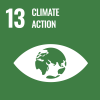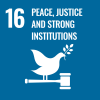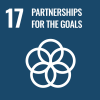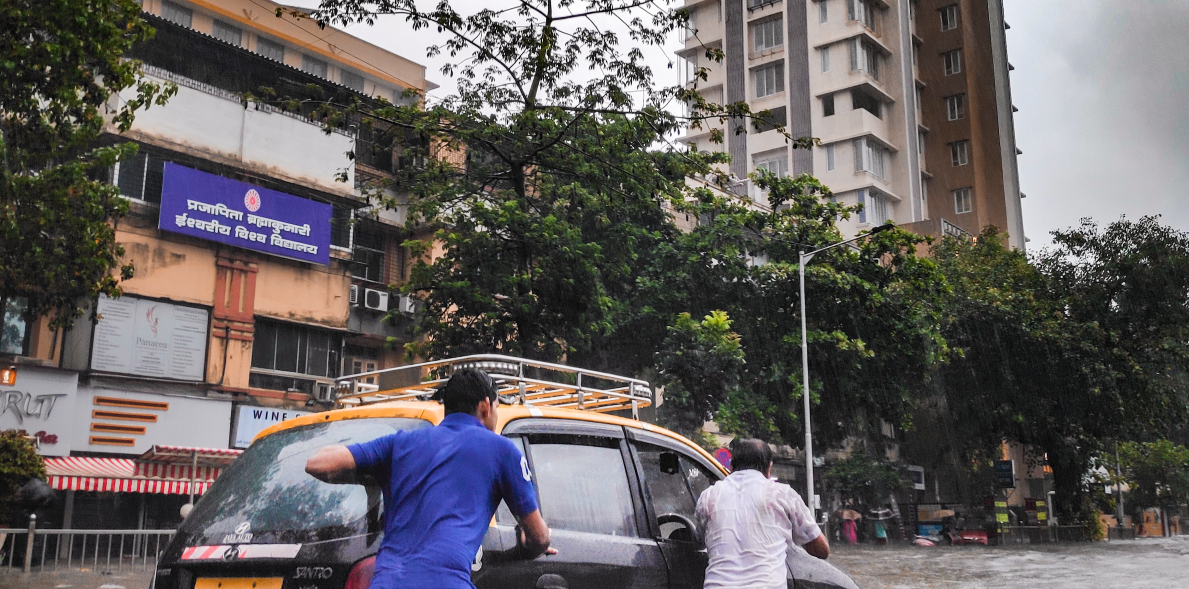
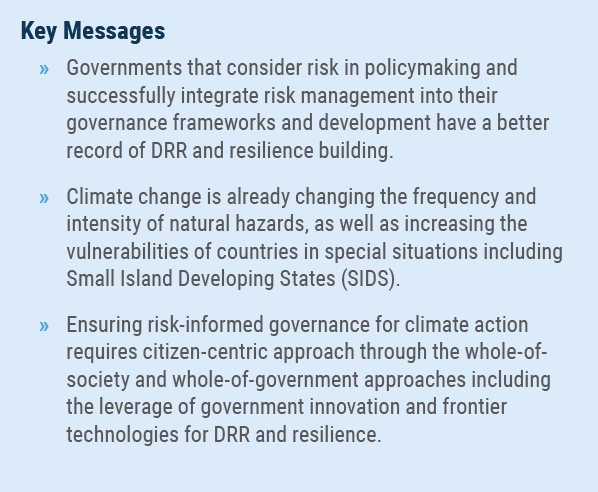 Global Trends in Disasters and its Consequences on Societies
Global Trends in Disasters and its Consequences on Societies
Emerging trends globally show that there is a stark upsurge in the number of disasters in this century compared to the previous one. Over the past two decades, climate-related disasters have nearly doubled compared to the preceding twenty years, affecting more than 4 billion people. According to the UN Office for Disaster Risk Reduction (UNDRR) Human Cost of Disaster Report 2020, “In the period 2000 to 2019, there were 7,348 major recorded disaster events claiming 1.23 million lives, affecting 4.2 billion people, and resulting in approximately US$2.97 trillion in global economic losses” This trend is expected to continue as carbon dioxide concentrations are now at the highest level in at least 2 million years with about 148% above pre-industrial levels. According to the Asia Pacific Disaster Report 2021 by ESCAP, “Fewer people are dying as a result of natural hazards as countries have been devising more robust systems of early warning and responsive protection.” Global temperatures are projected to rise by up to 3.2°C by 2100 (UN DESA, 2021) with average annual losses estimated to increase up to US$415 billion by 2030. Small Island Developing States (SIDS) in particular are the most susceptible to disasters. With an ever-increasing rate, SIDS are consistently hit by severe storms and other catastrophes, resulting on average an annual loss of 2.1 percent of Gross Domestic Product (GDP). The Intergovernmental Panel on Climate Change (IPCC) in its report of August 2021 issued a code red for humanity. The UN Secretary-General António Guterres emphasized that the window of opportunity to prevent the worst climate impacts is rapidly closing as no region is immune to the impending disaster. As the COVID-19 pandemic continues to cause immense suffering, it is also undermining governments’ ability to respond to climate change, disaster risk and resilience. For instance, while SIDS contribute little to the climate change problem globally by emitting less than 1 percent of global emissions, they however suffer disproportionately from climate impacts. In this context, this policy brief examines how to strengthen disaster risk reduction and resilience for climate action through risk-informed governance as illustrated in Figure 1.
 What is Risk-informed Governance for Disaster Risk Reduction (DRR) and Resilience?
What is Risk-informed Governance for Disaster Risk Reduction (DRR) and Resilience?
While resilience refers to the ability of a system, community exposed to hazards to resist, absorb, accommodate, adapt to, transform and recover from the effects of a hazard in a timely and efficient manner; risk-informed governance focuses on preventing new and reducing existing disaster risk and managing residual risk. Risk-informed governance also refers to integrating DRR strategies into the disaster preparedness process, land-use planning, investment decisions, urban development, and economic development plans for effective management and recovery at all levels of society. Managing disaster and climate risk therefore requires strong governance systems exemplified by appropriate laws and policies, strong leadership, institutions and coordination mechanisms, clear roles and responsibilities, resources, monitoring, and accountability set up across all sectors, and levels.
Why is Risk-informed Governance Critical for DRR and Resilience?
The 2030 Agenda for Sustainable Development places great significance on DRR as a cross-cutting element in achieving the Sustainable Development Goals (SDGs). Reducing disaster risk and strengthening resilience are interrelated thrusts of the 2030 Agenda for Sustainable Development, the Paris Agreement and the Sendai Framework for Disaster Risk Reduction 2015-2030. The Sendai Framework calls on governments to move towards risk-informed governance arrangements that include broader hazard and risk scope and incorporate the concept of systemic risk. Priority 2 of the Sendai Framework expressly calls for strengthening disaster risk governance to manage disaster risk. The principles of effective governance for sustainable development, established by the UN Committee of Experts on Public Administration (CEPA) and endorsed by the Economic and Social Council in 2018, also call for putting in place promotion of coherent policymaking, strategic planning foresight and risk management frameworks in the public sector as some of the strategies for sound policymaking. Strategies to implement the principles of effective governance provide practical guidance on the implementation of the 2030 Agenda and contribute to strengthening the effectiveness of institutions. Strategic guidance notes, developed in 2021 to operationalize the principle of sound policymaking, show the effectiveness of risk-informed government, including for DRR and responding swiftly to the COVID-19 crisis. The impact of the COVID-19 pandemic has underscored the importance of strategic planning and foresight, an organized, systematic way of looking beyond the expected to engage with uncertainty and complexity. The pandemic has also brought renewed attention to the importance of strengthening multi-hazard DRR and risk governance to build a safer and more resilient world. Risk management frameworks shows how the identification, measurement, monitoring, and evaluation of diverse risks followed by a coordinated and cost-effective application of resources can minimize and control the probability and impact of exposure and to try to maximize the realization of possible returns.
What are the Challenges in Strengthening DRR and Resilience for Climate Action through Risk-informed Governance?
Governments across the world are currently faced with multiple challenges in fully strengthening their risk-informed governance systems to reduce disasters’ risk and build resilience. These include – ineffective leadership with weak national and local governance systems; poor and weak institutional arrangements, limited capacities and institutional coordination mechanisms, including poor national to local coordination; limited integration of global development goals into national policies, plans and programmes; lack of, or limited engagement of multi-stakeholders; ineffective and lack of risk-informed communication systems; inadequate adoption of frontier and innovative technologies; weak financial capacities and data to drive evidence-based and risk-informed decision-making among others. Addressing these challenges requires a holistic approach that embraces the unique context of each society.
Policy Recommendations and Key Building Blocks for Strengthening DRR and Resilience
Promote effective public governance and integrate risk-informed governance into DRR strategies
Promoting effective public governance for the SDGs and DRR require a multi-sectoral and multi-dimensional approach through the whole-of-government approach in planning to mitigate risk through investments in data, tools and methods that support risk identification, assessment, and management which is critical to building resilient societies. Governance is an important determining factor in the success or failure of DRR and Climate Change Adaptation. DRR also requires capable leadership that is effective, agile, inclusive, and risk-informed to act on scientific evidence and take note of and act upon climate-related disasters. Countries should therefore focus on mobilizing and allocating the needed resources and capacities to better plan, anticipate, implement, report, monitor and evaluate their DRR strategies while integrating DRR into their national plans and programmes. Strong and effective risk-informed leadership is thus at the core of building sustainable and resilient societies. Governments and leaders ought to promote transparency, inclusiveness, and accountability in risk-related decision-making by incorporating good governance practices and continuously learn from experience and science (UN DESA, 2021).
Foster sound policymaking
Governments must enhance sound policymaking, including risk management frameworks, and proactively equip themselves with the proper knowledge, tools, competencies for developing policies and planning for unknown future shocks that could disrupt social, economic, and environmental stability. CEPA has stated that to achieve their intended results, public policies are to be coherent with one another and founded on true or well-established grounds, in full accordance with fact, reason and good sense. The strategies for operationalizing sound policymaking developed by CEPA are strategic planning and foresight, regulatory impact analysis, promotion of coherent policymaking, strengthening national statistical systems, monitoring and evaluation systems, science-policy interface, risk management frameworks, and data sharing.
Increase investments in DRR, climate resilience and mobilize innovative finance
Investing in DRR and resilience saves lives and money as well as yields economic, social, and other environmental benefits that enhance the well-being and resilience of communities. The World Bank notes that every US$1 invested in making infrastructure disaster-resilient saves US$4 through fewer disruptions and reduced economic impacts, while the Global Center on Adaptation (GCA) highlights that spending US$800 million on early-warning systems in developing countries would avoid losses of between US$3 billion and US$16 billion per year. Exploring risk-informed, innovative and sustainable financing systems such as green bonds, public-private-people partnership (PPPP), and crowdfunding including forecast-based financing with coordinated multi-hazard early warning systems (EWS) are highly recommended for strengthening DRR and resilience especially in SIDS who are at the forefront of multiple global catastrophes.
Increase resilience of infrastructure systems and adopt a strategic approach to resilience
The resilience of existing infrastructure systems can be increased by enhancing local and national government capacities to manage infrastructure assets proactively as an interconnected system based and led by data and evidence. Sound infrastructure asset management can involve a series of soft interventions, such as changing maintenance schedules based on vulnerability and risk assessments, or structural measures, such as raising the height of bridges to account for sea-level rise. It is therefore critical to ensure the resilience of infrastructure assets, the services they provide, and communities they serve by building capacities at the local and national levels to manage infrastructure assets proactively over their entire lifespan and as an interconnected system. Strategies for building resilience include the adoption of coping capacities to be able to survive and respond to shocks, reinforcing EWS and strengthening DRR strategies especially in SIDS which has inherently high pre-existing vulnerabilities to disasters.
Integrate and mainstream human rights-based approaches and gender issues
Leaving no one behind requires the integration and mainstreaming human rights-based approaches including the engagement and empowerment of women as well as prioritizing the needs of people in vulnerable situations in the design and implementation of policies and programmes since they are disproportionately affected in times of disasters.
Promote multi-stakeholder engagement, international and regional partnerships, and cooperation
Stakeholder engagement through the whole-of-society approach and effective partnerships are important since disaster risk management requires diverse stakeholders working collaboratively to share information, expertise, resources, and technology. Disaster risk is a shared responsibility, and all including citizens, public and private sectors and civil society organizations ought to participate, because DRR requires a people-centered approach. International and regional partnerships and cooperation through North-South, South-South and triangular cooperation through research, information and technology sharing, resource mobilization and exchange of lessons on good practices on DRR are essential. In particular, strategic partnerships are critical and presents enormous opportunities for countries in special situations including SIDS.
Leverage government innovation and frontier technologies
Frontier technologies including Information and Communications Technologies (ICTs) such as artificial intelligence (AI), drones, and big data analytics provide immense opportunities for strengthening risk-informed governance. Improved data collection, analysis, application, and data governance can provide enormous benefits by reducing economic losses, saving lives, improving livelihoods, and managing disaster risk. Innovative technologies including open government data, enhances the accuracy of risk assessment, contributes to effective measures to anticipate, prevent, prepare, mitigate, and manage disaster risk. UN DESA’s Curriculum on Governance for the SDGs toolkit on Risk-informed Governance for DRR provides more details. It is important to develop and strengthen integrated, robust, reliable, quality, timely, and disaggregated data systems to ensure evidence-based and data-driven decision making to better plan, predict, respond, and recover from disasters more effectively and efficiently.
Build capacities and change mindsets of public servants and community members
Building capacities of governments, experts and community members with up-to-date skills and competencies is critical to strengthening risk-informed governance for building back and forward better, especially in this Decade of Action. Building DRR capacities is as significant as the risk reduction measures themselves. SDG target 3.d, calls for “Strengthened capacities of all countries, in particular developing countries, for early warning, risk reduction and management of national and global health risks”. It is important to build capacities and change mindsets of communities and stakeholders to be able to accurately anticipate, cope with, resist and recover from disaster risk situations. Public servants need to embrace an agile mindset and develop competencies in systems-thinking to perceive the links, cause-effect relations, and dynamics affecting sustainable development and risk-informed adaptation to maintain effectiveness when experiencing change.
Foster effective risk-informed communication and awareness campaigns
In conclusion, improving disaster risk management is vital and this requires a deeper understanding among the citizenry of what, where and how disaster occurs, the losses it produces and how to prevent them. Being able to accurately predict, identify, assess, and understand disaster risk through effective risk communication and awareness raising is critical to reducing it.
 Welcome to the United Nations
Welcome to the United Nations
